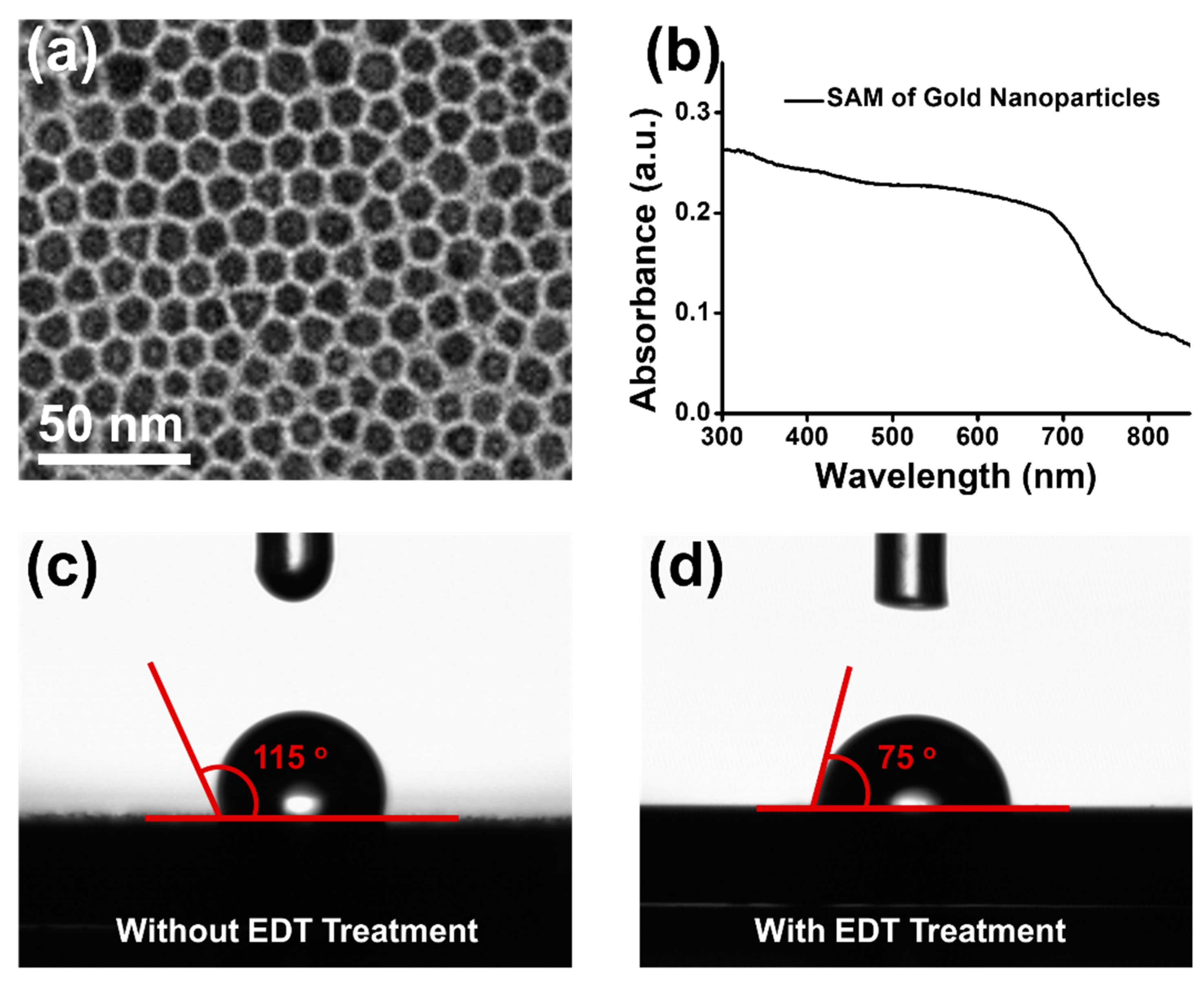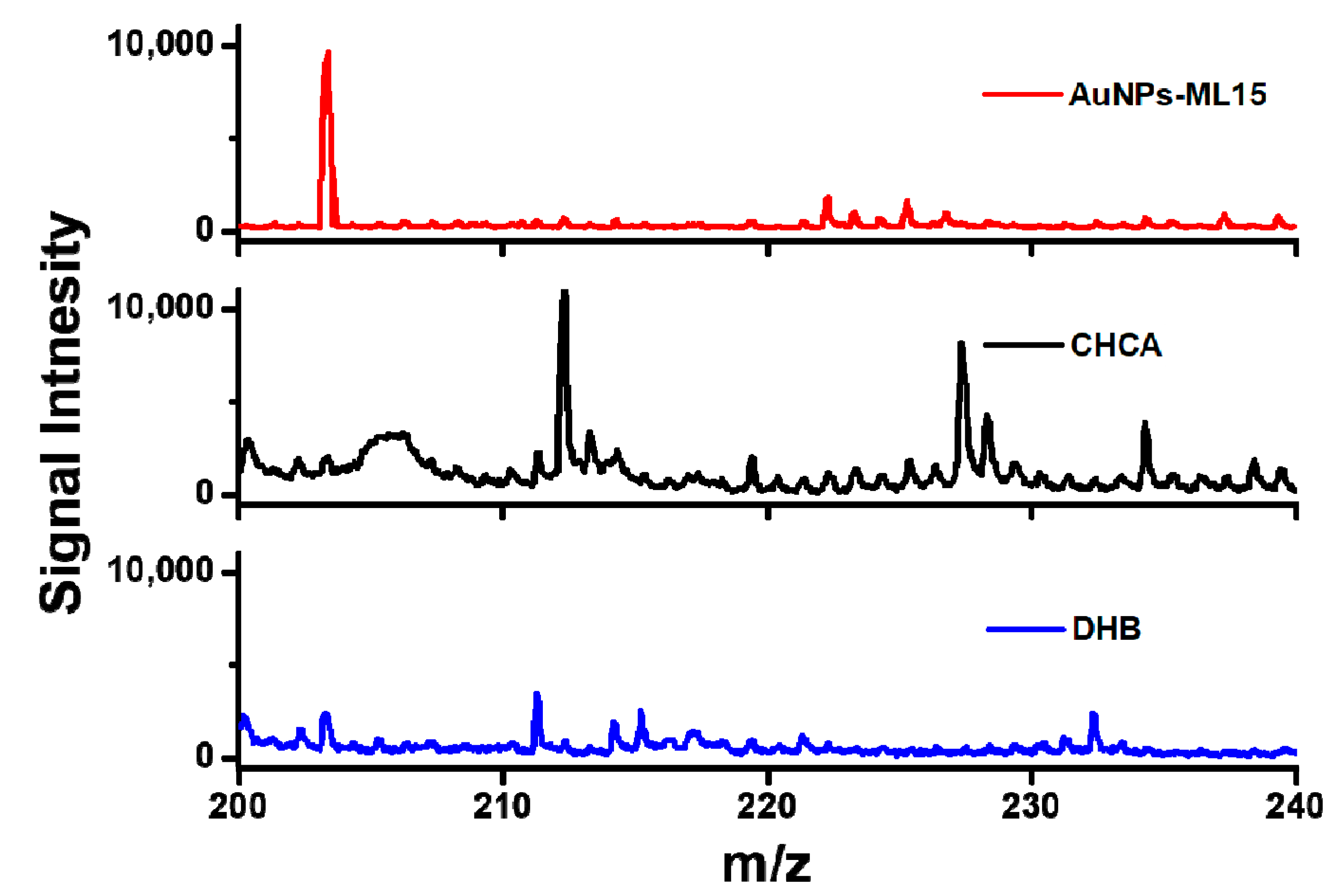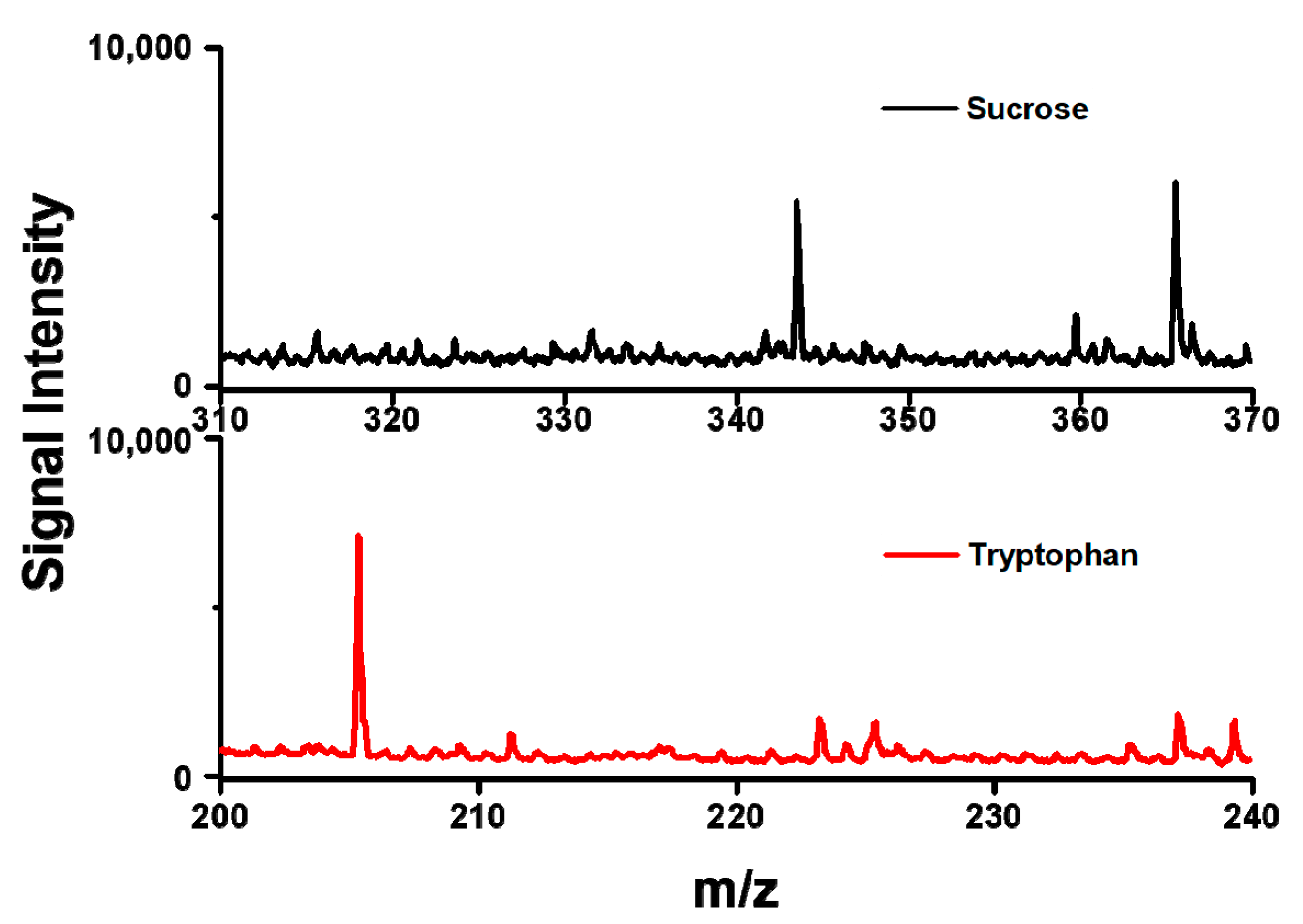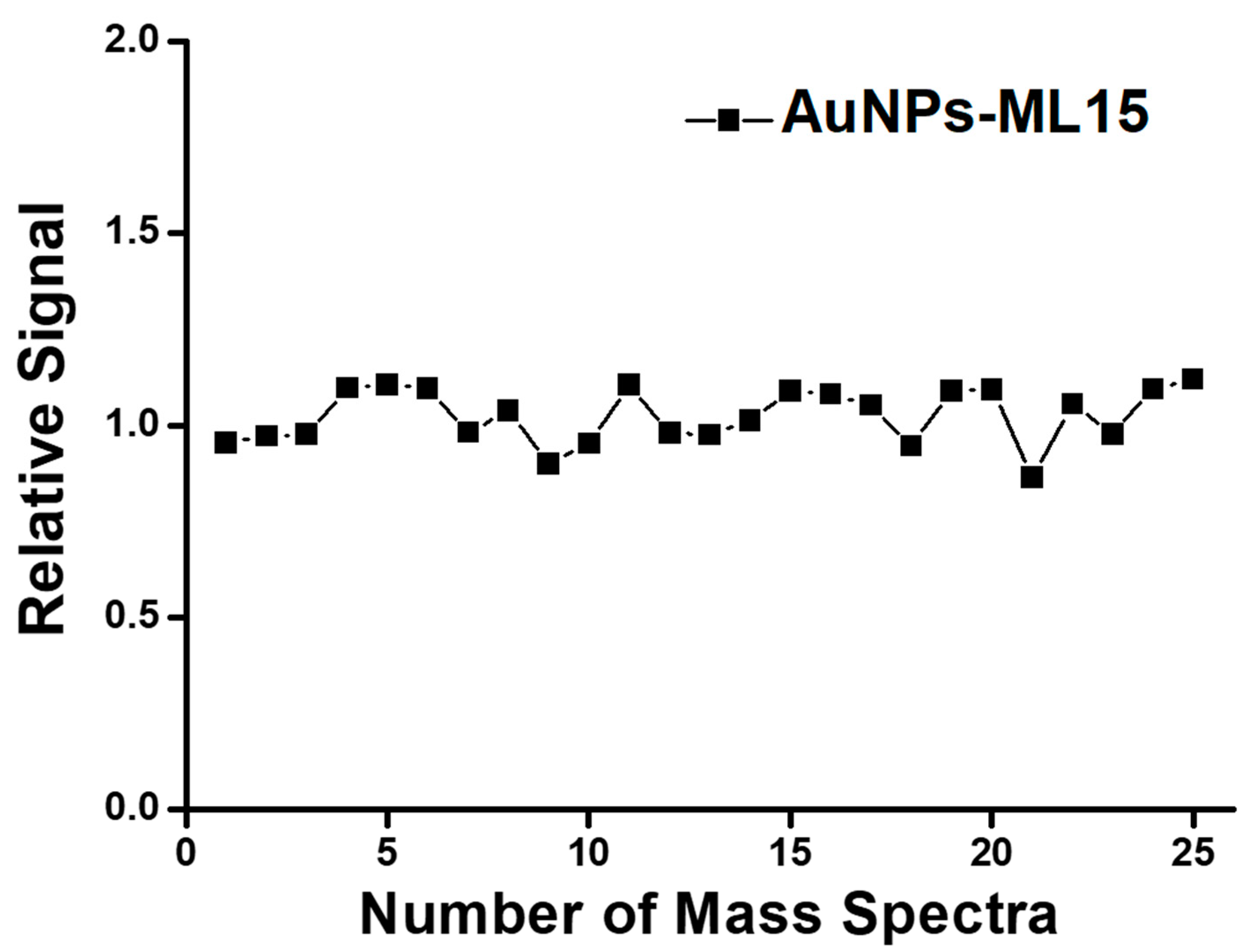High-Performance Sample Substrate of Gold Nanoparticle Multilayers for Surface-Assisted Laser Desorption/Ionization Mass Spectrometry
Abstract
1. Introduction
2. Materials and Methods
2.1. Chemicals
2.2. Preparation of Gold Nanoparticles
2.3. Fabrication of Self-Assembled Monolayer of Gold Nanoparticles
2.4. Gold Nanoparticle Multilayers as the Sample Substrates for SALDI-MS Measurements
2.5. SALDI-MS Measurements
3. Results and Discussion
3.1. Structural and Optical Properties of Gold Nanoparticles
3.2. Characterizations of Self-Assembled Monolayer of Gold Nanoparticles
3.3. Investigation of Gold Nanoparticle Multilayers as the Sample Substrates in SALDI-MS
3.4. Merchant Matrixes and AuNPs-ML for SALDI-MS Measurements
3.5. Detections of Sucrose and Tryptophan
3.6. Signal Reproducibility of AuNPs-ML Sample Substrate in SALDI-MS
4. Conclusions
Supplementary Materials
Author Contributions
Funding
Acknowledgments
Conflicts of Interest
References
- Pan, X.Y.; Chen, C.H.; Chang, Y.H.; Wang, D.Y.; Lee, Y.C.; Liou, C.C.; Wang, Y.X.; Hu, C.C.; Kuo, T.R. Osteoporosis risk assessment using multilayered gold-nanoparticle thin film via SALDI-MS measurement. Anal. Bioanal. Chem. 2019, 411, 2793–2802. [Google Scholar] [CrossRef] [PubMed]
- Kawasaki, H.; Yao, T.; Suganuma, T.; Okumura, K.; Iwaki, Y.; Yonezawa, T.; Kikuchi, T.; Arakawa, R. Platinum nanaflowers on scratched silicon by galvanic displacement for an effective SALDI substrate. Chem. Eur. J. 2010, 16, 10832–10843. [Google Scholar] [CrossRef] [PubMed]
- Law, K.P.; Larkin, J.R. Recent advances in SALDI-MS techniques and their chemical and bioanalytical applications. Anal. Bioanal. Chem. 2011, 399, 2597–2622. [Google Scholar] [CrossRef] [PubMed]
- Liu, Q.; Xiao, Y.S.; Pagan-Miranda, C.; Chiu, Y.M.; He, L. Metabolite imaging using matrix-enhanced surface-assisted laser desorption/ionization mass spectrometry (ME-SALDI-MS). J. Am. Soc. Mass. Spectrom. 2009, 20, 80–88. [Google Scholar] [CrossRef] [PubMed]
- Rowell, F.; Seviour, J.; Lim, A.Y.; Elumbaring-Salazar, C.G.; Loke, J.; Ma, J. Detection of nitro-organic and peroxide explosives in latent fingermarks by DART- and SALDI-TOF-mass spectrometry. Forensic Sci. Int. 2012, 221, 84–91. [Google Scholar] [CrossRef] [PubMed]
- Tang, H.W.; Ng, K.M.; Lu, W.; Che, C.M. Ion desorption efficiency and internal energy transfer in carbon-based surface-assisted laser desorption/ionization mass spectrometry: Desorption mechanism(s) and the design of SALDI substrates. Anal. Chem. 2009, 81, 4720–4729. [Google Scholar] [CrossRef] [PubMed]
- Watanabe, T.; Kawasaki, H.; Yonezawa, T.; Arakawa, R. Surface-assisted laser desorption/ionization mass spectrometry (SALDI-MS) of low molecular weight organic compounds and synthetic polymers using zinc oxide (ZnO) nanoparticles. J. Mass Spectrom. 2008, 43, 1063–1071. [Google Scholar] [CrossRef] [PubMed]
- Kurylo, I.; Hamdi, A.; Addad, A.; Boukherroub, R.; Coffinier, Y. Comparison of Ti-based coatings on silicon nanowires for phosphopeptide enrichment and their laser assisted desorption/ionization mass spectrometry detection. Nanomaterials 2017, 7, 272. [Google Scholar] [CrossRef]
- Lu, M.H.; Yang, X.Q.; Yang, Y.X.; Qin, P.; Wu, X.R.; Cai, Z.W. Nanomaterials as assisted matrix of laser desorption/ionization time-of-flight mass spectrometry for the analysis of small molecules. Nanomaterials 2017, 7, 87. [Google Scholar] [CrossRef]
- Pomastowski, P.; Buszewski, B. Complementarity of matrix and nanostructure-assisted laser desorption/ionization approaches. Nanomaterials 2019, 9, 260. [Google Scholar] [CrossRef]
- Wang, S.; Niu, H.; Cao, D.; Cai, Y. Covalent-organic frameworks as adsorbent and matrix of SALDI-TOF MS for the enrichment and rapid determination of fluorochemicals. Talanta 2019, 194, 522–527. [Google Scholar] [CrossRef] [PubMed]
- Cheng, Y.H.; Zhang, Y.; Chau, S.L.; Lai, S.K.M.; Tang, H.W.; Ng, K.M. Enhancement of image contrast, stability, and SLADI-MS detection sensitivity for latent fingerprint analysis by tuning the composition of silver-gold nanoalloys. ACS Appl. Mater. Interfaces 2016, 8, 29668–29675. [Google Scholar] [CrossRef] [PubMed]
- Guinan, T.; Ronci, M.; Vasani, R.; Kobus, H.; Voelcker, N.H. Comparison of the performance of different silicon-based SALDI substrates for illicit drug detection. Talanta 2015, 132, 494–502. [Google Scholar] [CrossRef] [PubMed]
- Kailasa, S.K.; Wu, H.F. Interference free detection for small molecules: Probing the Mn2+-doped effect and cysteine capped effect on the ZnS nanoparticles for coccidiostats and peptide analysis in SALDI-TOF ms. Analyst 2010, 135, 1115–1123. [Google Scholar] [CrossRef] [PubMed]
- Kim, J.I.; Park, J.M.; Hwang, S.J.; Kang, M.J.; Pyun, J.C. Top-down synthesized TiO2 nanowires as a solid matrix for surface-assisted laser desorption/ionization time-of-flight (SALDI-TOF) mass spectrometry. Anal. Chim. Acta 2014, 836, 53–60. [Google Scholar] [CrossRef]
- Li, Z.; Zhang, Y.W.; Xin, Y.L.; Bai, Y.; Zhou, H.H.; Liu, H.W. A lithium-rich composite metal oxide used as a SALDI-MS matrix for the determination of small biomolecules. Chem. Commun. 2014, 50, 15397–15399. [Google Scholar] [CrossRef] [PubMed]
- Liu, Q.; He, L. Ionic matrix for matrix-enhanced surface-assisted laser desorption ionization mass spectrometry imaging (ME-SALDI-MSI). J. Am. Soc. Mass. Spectrom. 2009, 20, 2229–2237. [Google Scholar] [CrossRef] [PubMed][Green Version]
- Amini, N.; Shariatgorji, M.; Thorsen, G. SALDI-MS signal enhancement using oxidized graphitized carbon black nanoparticles. J. Am. Soc. Mass. Spectrom. 2009, 20, 1207–1213. [Google Scholar] [CrossRef] [PubMed][Green Version]
- Duan, J.C.; Wang, H.; Cheng, Q.A. On-plate desalting and SALDI-MS analysis of peptides with hydrophobic silicate nanofilms on a gold substrate. Anal. Chem. 2010, 82, 9211–9220. [Google Scholar] [CrossRef] [PubMed]
- Lim, A.Y.; Ma, J.; Boey, Y.C.F. Development of nanomaterials for SALDI-MS analysis in forensics. Adv. Mater. 2012, 24, 4211–4216. [Google Scholar] [CrossRef] [PubMed]
- Nitta, S.; Kawasaki, H.; Suganuma, T.; Shigeri, Y.; Arakawa, R. Desorption/ionization efficiency of common amino acids in surface-assisted laser desorption/ionization mass spectrometry (SALDI-MS) with nanostructured platinum. J. Phys. Chem. C 2013, 117, 238–245. [Google Scholar] [CrossRef]
- Wang, X.; Teng, F.; Wang, Y.; Lu, N. Rapid liquid-phase microextraction of analytes from complex samples on superwetting porous silicon for onsite SALDI-MS analysis. Talanta 2019, 198, 63–70. [Google Scholar] [CrossRef] [PubMed]
- Al-Hetlani, E.; Amin, M.O.; Madkour, M.; Nazeer, A.A. CeO2-CB nanocomposite as a novel SALDI substrate for enhancing the detection sensitivity of pharmaceutical drug molecules in beverage samples. Talanta 2018, 185, 439–445. [Google Scholar] [CrossRef] [PubMed]
- Kim, K.; Um, K.; Yoon, C.; Ryoo, W.S.; Lee, K. Wafer-level detection of organic contamination by ZnO-rGO hybrid-assisted laser desorption/ionization time-of-flight mass spectrometry. Talanta 2018, 182, 273–278. [Google Scholar] [CrossRef] [PubMed]
- Abdelmaksoud, H.H.; Guinan, T.M.; Voelcker, N.H. Fabrication of nanostructured mesoporous germanium for application in laser desorption ionization mass spectrometry. ACS Appl. Mater. Interfaces 2017, 9, 5092–5099. [Google Scholar] [CrossRef]
- Wang, C.W.; Chen, W.T.; Chang, H.T. Quantification of saccharides in honey samples through surface-assisted laser desorption/ionization mass spectrometry using HgTe nanostructures. J. Am. Soc. Mass. Spectrom. 2014, 25, 1247–1252. [Google Scholar] [CrossRef]
- Grzelczak, M.; Perez-Juste, J.; Mulvaney, P.; Liz-Marzan, L.M. Shape control in gold nanoparticle synthesis. Chem. Soc. Rev. 2008, 37, 1783–1791. [Google Scholar] [CrossRef]
- Heaven, M.W.; Dass, A.; White, P.S.; Holt, K.M.; Murray, R.W. Crystal structure of the gold nanoparticle [N(C8H17)4] [Au25(SCH2CH2Ph)18]. J. Am. Chem. Soc. 2008, 130, 3754–3755. [Google Scholar] [CrossRef]
- Jadzinsky, P.D.; Calero, G.; Ackerson, C.J.; Bushnell, D.A.; Kornberg, R.D. Structure of a thiol monolayer-protected gold nanoparticle at 1.1 angstrom resolution. Science 2007, 318, 430–433. [Google Scholar] [CrossRef]
- Yang, W.C.D.; Wang, C.; Fredin, L.A.; Lin, P.A.; Shimomoto, L.; Lezec, H.J.; Sharma, R. Site-selective CO disproportionation mediated by localized surface plasmon resonance excited by electron beam. Nat. Mater. 2019, 18, 614. [Google Scholar] [CrossRef]
- Gong, H.M.; Yang, Y.Q.; Chen, X.X.; Zhao, D.; Chen, X.; Chen, Y.T.; Yan, M.; Li, Q.; Qiu, M. Gold nanoparticle transfer through photothermal effects in a metamaterial absorber by nanosecond laser. Sci. Rep. 2014, 4, 6080. [Google Scholar] [CrossRef]
- Hatef, A.; Meunier, M. Plasma-mediated photothermal effects in ultrafast laser irradiation of gold nanoparticle dimers in water. Opt. Express 2015, 23, 1967–1980. [Google Scholar] [CrossRef]
- Nam, J.; Nam, H.; Jung, S.; Hwang, S.; Wang, T.; Hur, J.; Im, K.; Park, N.; Kim, K.H.; Kim, S. Unique photothermal response and sustained photothermal effect of Ph-responsive gold-nanoparticle aggregates. ChemPhysChem 2012, 13, 4105–4109. [Google Scholar] [CrossRef]
- Wang, J.; Zhang, Y.; Jin, N.; Mao, C.B.; Yang, M.Y. Protein-induced gold nanoparticle assembly for improving the photothermal effect in cancer therapy. ACS Appl. Mater. Interfaces 2019, 11, 11136–11143. [Google Scholar] [CrossRef]
- Wang, G.R.; Wang, L.; Rendeng, Q.; Wang, J.; Luo, J.; Zhong, C.-J. Correlation between nanostructural parameters and conductivity properties for molecularly-mediated thin film assemblies of gold nanoparticles. J. Mater. Chem. 2007, 17, 457–462. [Google Scholar] [CrossRef]
- Pełka, J.; Brust, M.; Gierłowski, P.; Paszkowicz, W.; Schell, N. Structure and conductivity of self-assembled films of gold nanoparticles. Appl. Phys. Lett. 2006, 89, 063110. [Google Scholar] [CrossRef]
- Shalkevich, N.; Escher, W.; Bürgi, T.; Michel, B.; Si-Ahmed, L.; Poulikakos, D. On the heat conductivity of gold nanoparticle colloids. Langmuir 2009, 26, 663–670. [Google Scholar] [CrossRef]
- Su, C.-L.; Tseng, W.-L. Gold nanoparticles as assisted matrix for determining neutral small carbohydrates through laser desorption/ionization time-of-flight mass spectrometry. Anal. Chem. 2007, 79, 1626–1633. [Google Scholar] [CrossRef]
- Kuo, T.R.; Chen, J.S.; Chiu, Y.C.; Tsai, C.Y.; Hu, C.C.; Chen, C.C. Quantitative analysis of multiple urinary biomarkers of carcinoid tumors through gold-nanoparticle-assisted laser desorption/ionization time-of-flight mass spectrometry. Anal. Chim. Acta 2011, 699, 81–86. [Google Scholar] [CrossRef]
- Kailasa, S.K.; Wu, H.F. One-pot synthesis of dopamine dithiocarbamate functionalized gold nanoparticles for quantitative analysis of small molecules and phosphopeptides in SALDI- and MALDI-ms. Analyst 2012, 137, 1629–1638. [Google Scholar] [CrossRef]
- Arendowski, A.; Szulc, J.; Nizioł, J.; Gutarowska, B.; Ruman, T. Metabolic profiling of moulds with laser desorption/ionization mass spectrometry on gold nanoparticle enhanced target. Anal. Biochem. 2018, 549, 45–52. [Google Scholar] [CrossRef]
- Teng, F.; Zhu, Q.Y.; Wang, Y.L.; Du, J.; Lu, N. Enhancing reproducibility of SALDI MS detection by concentrating analytes within laser spot. Talanta 2018, 179, 583–587. [Google Scholar] [CrossRef]
- Zhu, Q.Y.; Teng, F.; Wang, Z.S.; Wang, Y.L.; Lu, N. Confining analyte droplets on visible Si pillars for improving reproducibility and sensitivity of SALDI-TOF MS. Anal. Bioanal. Chem. 2019, 411, 1135–1142. [Google Scholar] [CrossRef]
- Wu, H.-P.; Su, C.L.; Chang, H.C.; Tseng, W.L. Sample-first preparation: A method for surface-assisted laser desorption/ionization time-of-flight mass spectrometry analysis of cyclic oligosaccharides. Anal. Chem. 2007, 79, 6215–6221. [Google Scholar] [CrossRef]
- Castellana, E.T.; Russell, D.H. Tailoring nanoparticle surface chemistry to enhance laser desorption ionization of peptides and proteins. Nano Lett. 2007, 7, 3023–3025. [Google Scholar] [CrossRef]
- Meng, X.; Hu, J.J.; Chao, Z.C.; Liu, Y.; Ju, H.X.; Cheng, Q. Thermoresponsive arrays patterned via photoclick chemistry: Smart MALDI plate for protein digest enrichment, desalting, and direct ms analysis. ACS Appl. Mater. Interfaces 2018, 10, 1324–1333. [Google Scholar] [CrossRef]
- Picca, R.A.; Calvano, C.D.; Cioffi, N.; Palmisano, F. Mechanisms of nanophase-induced desorption in LDI-MS. A short review. Nanomaterials 2017, 7, 75. [Google Scholar] [CrossRef]
- Xu, Q.; Tian, R.; Lu, C.; Li, H.F. Monodispersed Ag nanoparticle in layered double hydroxides as matrix for laser desorption/ionization mass spectrometry. ACS Appl. Mater. Interfaces 2018, 10, 44751–44759. [Google Scholar] [CrossRef]
- Gao, C.; Zhen, D.; He, N.; An, Z.; Zhou, Q.; Li, C.; Grimes, C.A.; Cai, Q. Two-dimensional TiO2 nanoflakes enable rapid SALDI-TOF-MS detection of toxic small molecules (dyes and their metabolites) in complex environments. Talanta 2019, 196, 1–8. [Google Scholar] [CrossRef]
- Kuo, T.-R.; Wang, D.-Y.; Chiu, Y.-C.; Yeh, Y.-C.; Chen, W.-T.; Chen, C.-H.; Chen, C.-W.; Chang, H.-C.; Hu, C.-C.; Chen, C.-C. Layer-by-layer thin film of reduced graphene oxide and gold nanoparticles as an effective sample plate in laser-induced desorption/ionization mass spectrometry. Anal. Chim. Acta 2014, 809, 97–103. [Google Scholar] [CrossRef]
- Hong, M.; Xu, L.; Wang, F.; Geng, Z.; Li, H.; Wang, H.; Li, C.Z. A direct assay of carboxyl-containing small molecules by SALDI-MS on a AgNP/rGO-based nanoporous hybrid film. Analyst 2016, 141, 2712–2726. [Google Scholar] [CrossRef]
- Liu, R.; Liu, J.F.; Zhou, X.X.; Jiang, G.B. Cysteine modified small ligament Au nanoporous film: An easy fabricating and highly efficient surface-assisted laser desorption/ionization substrate. Anal. Chem. 2011, 83, 3668–3674. [Google Scholar] [CrossRef]
- Kuo, T.R.; Chen, Y.C.; Wang, C.I.; Shen, T.H.; Wang, H.Y.; Pan, X.Y.; Wang, D.Y.; Liou, C.C.; Chang, Y.H.; Wu, Y.H.; et al. Highly oriented Langmuir-Blodgett film of silver cuboctahedra as an effective matrix-free sample plate for surface-assisted laser desorption/ionization mass spectrometry. Nanoscale 2017, 9, 11119–11125. [Google Scholar] [CrossRef]
- Xie, J.; Peng, S.; Brower, N.; Pourmand, N.; Wang, S.X.; Sun, S. One-pot synthesis of monodisperse iron oxide nanoparticles for potential biomedical applications. Pure Appl. Chem. 2006, 78, 1003–1014. [Google Scholar] [CrossRef]
- Grzelczak, M.; Vermant, J.; Furst, E.M.; Liz-Marzan, L.M. Directed self-assembly of nanoparticles. ACS Nano 2010, 4, 3591–3605. [Google Scholar] [CrossRef]
- Tao, A.; Sinsermsuksakul, P.; Yang, P. Tunable plasmonic lattices of silver nanocrystals. Nat. Nanotechnol. 2007, 2, 435–440. [Google Scholar] [CrossRef]
- Jain, P.K.; El-Sayed, M.A. Plasmonic coupling in noble metal nanostructures. Chem. Phys. Lett. 2010, 487, 153–164. [Google Scholar] [CrossRef]
- Yang, H.; Wu, T.; Hu, T.; Hu, X.; Chen, L.; Chen, Y. A homogeneous ethanedithiol doped ZnO electron transporting layer for polymer solar cells. J. Mater. Chem. 2016, 4, 8738–8744. [Google Scholar] [CrossRef]







© 2019 by the authors. Licensee MDPI, Basel, Switzerland. This article is an open access article distributed under the terms and conditions of the Creative Commons Attribution (CC BY) license (http://creativecommons.org/licenses/by/4.0/).
Share and Cite
Liu, Y.-C.; Chang, Y.-H.; Lin, Y.-H.; Liou, C.-C.; Kuo, T.-R. High-Performance Sample Substrate of Gold Nanoparticle Multilayers for Surface-Assisted Laser Desorption/Ionization Mass Spectrometry. Nanomaterials 2019, 9, 1078. https://doi.org/10.3390/nano9081078
Liu Y-C, Chang Y-H, Lin Y-H, Liou C-C, Kuo T-R. High-Performance Sample Substrate of Gold Nanoparticle Multilayers for Surface-Assisted Laser Desorption/Ionization Mass Spectrometry. Nanomaterials. 2019; 9(8):1078. https://doi.org/10.3390/nano9081078
Chicago/Turabian StyleLiu, Yen-Chen, Yi-Hsuan Chang, Yun-Ho Lin, Chien-Chung Liou, and Tsung-Rong Kuo. 2019. "High-Performance Sample Substrate of Gold Nanoparticle Multilayers for Surface-Assisted Laser Desorption/Ionization Mass Spectrometry" Nanomaterials 9, no. 8: 1078. https://doi.org/10.3390/nano9081078
APA StyleLiu, Y.-C., Chang, Y.-H., Lin, Y.-H., Liou, C.-C., & Kuo, T.-R. (2019). High-Performance Sample Substrate of Gold Nanoparticle Multilayers for Surface-Assisted Laser Desorption/Ionization Mass Spectrometry. Nanomaterials, 9(8), 1078. https://doi.org/10.3390/nano9081078





